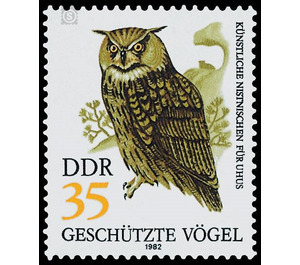Protected birds of prey - Germany / German Democratic Republic 1982 - 35 Pfennig
Theme: Animals
| Country | Germany / German Democratic Republic |
| Issue Date | 1982 |
| Face Value | 35.00 |
| Color | multi-colored |
| Perforation | K 14 |
| Printing Type | Rotogravure 2 |
| Stamp Type | Postage stamp |
| Item Type | Stamp |
| Chronological Issue Number | 2447 |
| Chronological Chapter | GER-DDR |
| SID | 774004 |
| In 13 Wishlists | |
Protected birds With the illustrations of protected birds, the Ministry of Posts and Telecommunications of the German Democratic Republic issues four multicolored special postage stamps. Special Cancellation from May 18 to July 17, 1982 Protected Birds Our birds of prey, as the final members of food chains, are among the most endangered species of birds as a result of the world's increased environmental pollution. Seven birds of prey occurring in the GDR were classified as "threatened with extinction" on the basis of § 14 of the Nature Conservation Order of 14 May 1970 and the order to protect wild plants and non-huntable, wild animals of 6 July 1970 and thus have the highest protection status. 35-pfennig value: Eagle owl with artificial nest roofing This largest species of owl was formerly not uncommon in Central Europe. Prejudices against their hidden way of life have long led to a strong persecution and since 1900 to a stock decline and later to the extinction of the deposits in the Harz, Erzgebirge and Elbe Sandstone Mountains as well as in Mecklenburg. In Thuringia and adjacent areas of the Vogtland, the eagle owl has been breeding successfully for several years in a landscape rich in forest and agricultural land. He prefers steep, scree-covered, loosely planted with limestone or slate mountain slopes. It prefers to hunt its prey in the evening and early morning hours in Talauen and on high surfaces in groves. It feeds on mice, hedgehogs, amphibians, frogs, hamsters, rats, crows, squirrels, thrushes, pigeons, wild rabbits and small birds of prey. The eggs are placed in a shallow hollow on the bare ground, preferably in rock crevices, under rock ledges and also under artificially created roofing. Disruptions during breeding lead to leaving the eggs and destroying the eggs. Through consistent protection against the visitors and predators by Horstbetreuer and Forstnutzungsruhe from January 1 to June 31 within 300 m around the clutch an increase in Uhupopulation was achieved on 35 breeding pairs.


